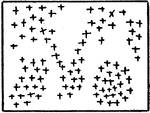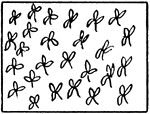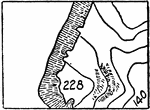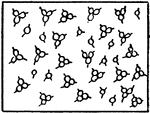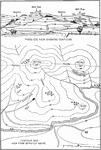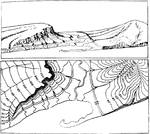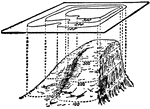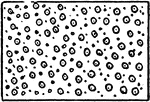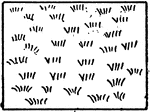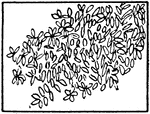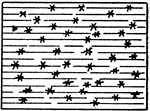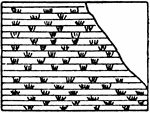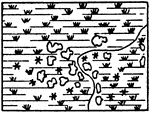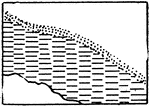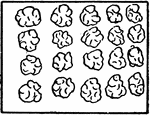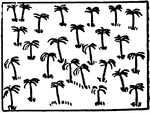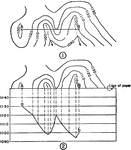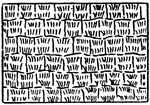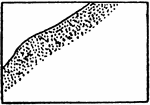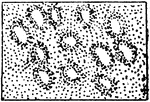This science ClipArt gallery offers 119 images of topography, which is the study of the Earth's surface. This is most often seen in map-making, when representing features of the Earth is represented by symbols.
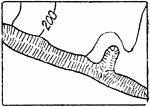
Bluffs, Other than Rocky
The typical representation of bluffs (other than rocky) on a topographical map.

Contour Lines
Contour lines never cross on the ground but in rare cases as an overhanging cliff they may cross on…

Contour Lines
A contour about to cross a stream runs up one side and down the other, making a V where it crosses,…
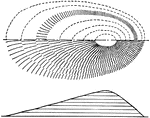
Shoreline Contour Map Method of Execution
"The contours are sketched lightly in pencil and the hachures drawn perpendicular to them, starting…

Shoreline Hill Shading by Hachures Contour Map
"The showing of relief by means of hill shading gives a pleasing effect but is very difficult of execution,…
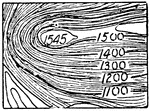
Contour System
In cartography, a contour line (often just called a "contour") joins points of equal elevation (height)…

Shoreline Contour
"A contour is a line on the surface of the ground which at every point passes through the same elevation,…

Contours
The diagram shows the principles of contours. The cones and domes from the side (a) are translated to…
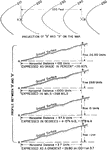
Contours to Slope
This diagram shows the translation of contours to finding the measurement of the slope in grade percent,…
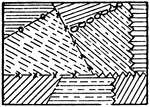
Cultivated Fields in General
The typical representation of cultivated fields in general on a topographical map.

Depression Contours
The typical representation of depression contours, if otherwise ambiguous, on a topographical map.

Fault Scarp Slope
"View of the southeastern slope of the eastern twin of Orenaug Hill. Fault scarps bound the hummocky…

Fault Scarps
"Fault scarps of Orenaug Hill (floating block topography). The view is taken from the top of a cliff…
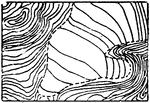
Glacier Contours
In cartography, a contour line (often just called a "contour") joins points of equal elevation (height)…

Glacier Form Lines
In cartography, a contour line (often just called a "contour") joins points of equal elevation (height)…
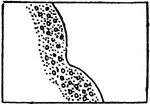
Gravel and Rocks
The typical representation of shores and low-water lines with gravel and rocks on a topographical map.
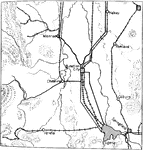
Hachures
Showing relief on a map using hachures: short parallel lines. Close together is a steeper incline, farther…

Map of the Arnold Arboretum
A map of the Arnold Arboretum. The arboretum is located in Jamaica Plain, Massachusetts. It is a department…

Water Lining Map Topography
"In water—lining a stream of varying width, the lines are not to be crowded so as to be carried…

Topographic Map
An illustration of a topographic map using conventional symbols commonly used in drafting and map drawing.

Topographic Architect Map
An architect's landscape map of a Texas Park illustrating a combination of conventional topographic…
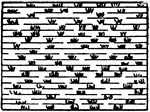
Fresh Marsh
The typical representation of a marsh in general (or fresh marsh) on a topographical map.
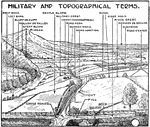
Military and Topographical Terms
Terms used to define features of the earth on a topographical map used by the military.
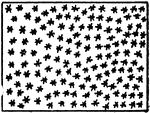
Pine (or Narrow Leaved Trees)
The typical representation of pine trees or any other narrow leaved trees on a topographical map.

Polyconic Projection
The development of polyconic projection: portraying a spherical object like the earth, on a flat surface.
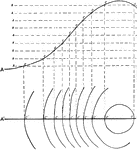
Profile to Contours
This diagram shows the translation from the profile of an incline to the contours in an above view.

Hasty Profile
The topographical map is used to construct a hasty profile in order to determine visibility.

Topographic Profiles
A profile is cross sectional view, or side view, showing elevation at a given distance. The illustration…
Relief Features
A diagram of the relief features: mountain, plateau, plain, ocean basin, ocean deep, and volcano.
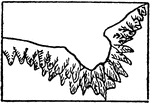
Rocky Ledges
The typical representation of shores and low-water lines with rocky ledges on a topographical map.

Perspective View of Shoreline
A perspective view of the shoreline illustrated by using contour lines.
